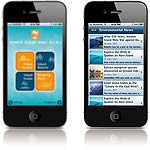In a world of satellite technology, what are the chances of discovering an unknown island? Yet one man can lay claim to just that, after stumbling across a brand new island in the South Pacific.
In a world of satellite technology, centuries after the golden era of Christopher Columbus and the other Great Explorers, you’d have to say that the chances of discovering an unknown island are very slim indeed. Yet one man can lay claim to just that after stumbling across a brand new island whilst sailing through the South Pacific. Private Island News caught up with Frederick Fransson to get the inside line on this unusual tale.
It was meant to be just another day’s plain sailing, as Captain Frederick Fransson and the crew of the yacht Maiken set sail from Tonga back to Brisbane in his native Australia. Yet the 11th August 2006 turned out to be anything but ordinary. What follows is a one in a lifetime experience which has eluded even the most seasoned of sea-dogs career: Captain Frederick Fransson gives his account of the birth of an island.
“We slowly motored off the island of Tonga and noticed grainy streaks in the water almost immediately,” he explained. Something was clearly amiss. Instead of the familiar deep blue of the South Pacific, the waters surrounding the Maiken were inexplicably turning to stone. “The sea just became thicker and thicker. The horizon looked like a desert – like rolling hills of sand as far as the eye could see. When we first encountered it was just a thin layer on the surface, but it soon became thick, piling up on the bow and taking our speed from 7 knots to 1 knot.”
Indeed, the layer of floating ash and rock was at times so thick that midway through the journey, it blocked the ship’s cooling system and threatened to overheat the engine. Yet Captain Fransson soldiered on, expertly maneuvering the Maiken through a kilometer-long labyrinth of pumice to venture ever closer to the source – a solid tower of blackness, which he soon came to realize was the result of an underwater volcano. What Fransson couldn’t know, however, was that just kilometers away, the ocean was violently thrusting up a fresh new island.
“Through the clouds on the horizon we saw this smokestack from the actual, active volcano,” continued Captain Fransson. “Of course we were curious to find out more, so we decided that we would sail right toward [the source]. Ash, stone, pumice and lava were spewing out of the ocean roughly every forty minutes, forming a massive black tower of matter. You could see it raining down into the ocean.”
Cautiously navigating towards the pillars of noxious black smoke, Fransson and his crew noted to their surprise that in the place of the underwater seamount listed in their shipping chart, there was a smoldering coal-black island – expanding with every explosion. “It was kind of beautiful – a smoking, smoldering mass that looked like coal. We could see new material piling up on it with every eruption.”
“I would say we were about 10-15 miles from it when the last of the big black eruptions took place but looking back it was amazing,” explained Fransson. “It’s not that many people who can be there actually seeing it first hand and being the first ones.” Not even the world’s most foremost scientists, geologists and volcanologists can lay claim to having such a phenomenal natural spectacle.
Whilst underwater volcanic eruptions can occur as often as 20+ times a year, they usually take place in remote destinations or at depths so extreme that there are rarely human witnesses. Teams of international scientists scrambled to organize research expeditions to the island, with the likes of NASA amongst the first to study the island-forming eruption using cutting-edge satellite technology to establish a clear picture of exactly what sort of structure had formed.
Volcanologist Scott Bryan, of London’s Kingston University was not quite so lucky. By the time he’d received the go-ahead to travel to Tonga and examine the island in person, Home Reef (as it had since been christened) had all but disappeared back into the lava-leaden waters of the Pacific, experiencing a similar fate to many other volcanic eruption islands.
Volcanic eruption islands are often ephemeral, lasting only a few months, says volcanologist Bryan. With a base of pumice and ash, these islands are simply not stable enough to survive life at open sea. Speaking to scientific journal, Discover Magazine, he explains: “Ultimately, it’s a battle between the frequency and volume of eruptions and the wave action taking it back down to sea level.”
Indeed a new map suggests that during the past 60 years, only six volcanic eruption islands have survived to tell the tale. Stay tuned to Private Island News for a summary of all six of the world’s newest naturally-formed pieces of land.
Related Articles:
- A New Island is Born After a Spectacular Explosion in Tonga (January 2015)
http://www.privateislandnews.com/20150129-pacific-ocean-a-new-island-is-born-after-spectacular-volcanic-eruption-in-tonga/
- Russian Military Helicopters Discover New Island in Arctic Waters (December 2014)
http://www.privateislandnews.com/arctic-russian-military-helicopters-discover-new-island-in-arctic-waters/ - An Island is Born – New Volcanic Island Continues to Grow and Grow (April 2014)
http://www.privateislandnews.com/japan-an-island-is-born-new-volcanic-island-continues-to-grow-and-grow/ - This Brand New Island Has a Very Famous Face (January 2014)
http://www.privateislandnews.com/japan-this-brand-new-island-has-a-very-famous-face/



